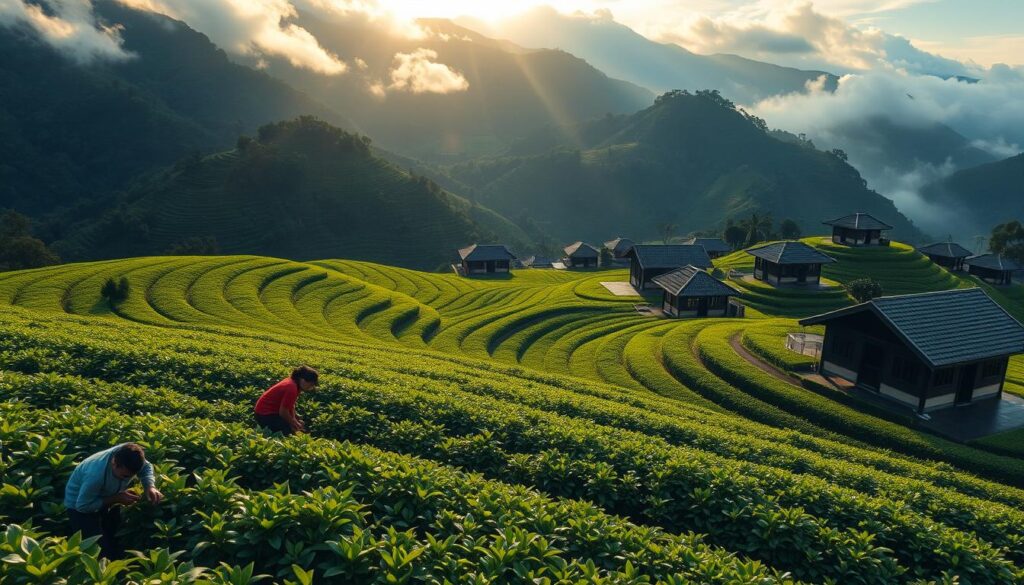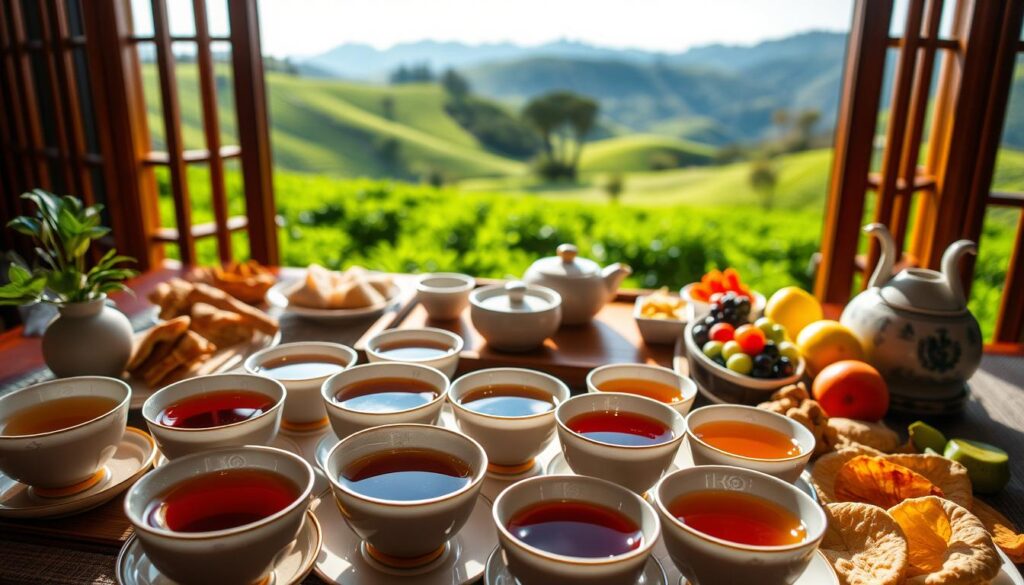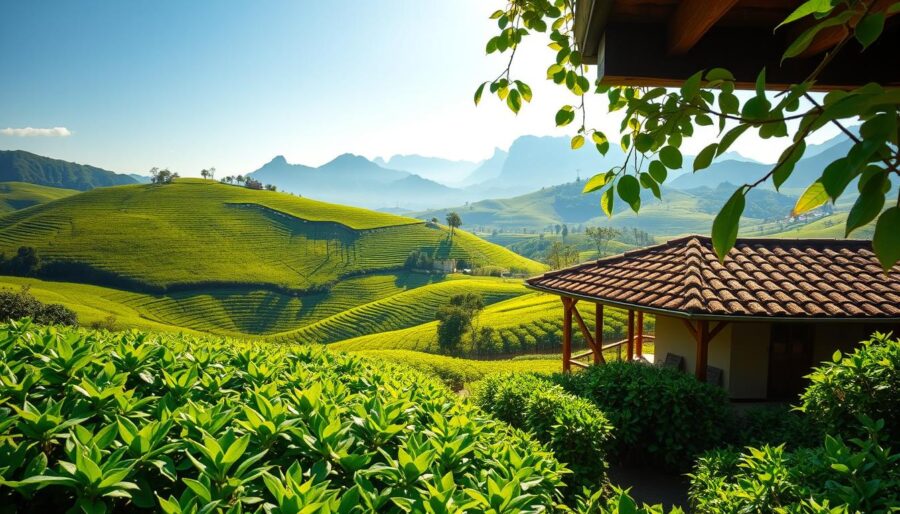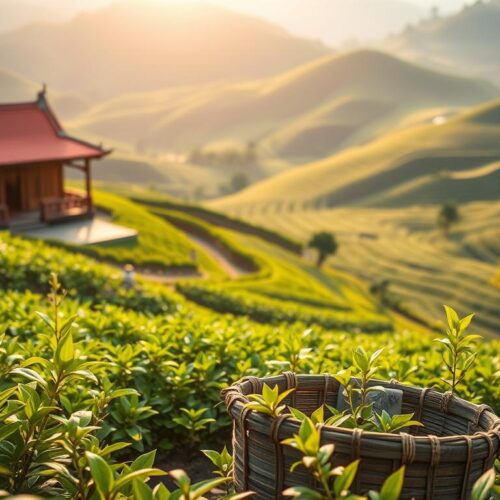Welcome to the enchanting world of Taiwan’s tea farms. Nestled in breathtaking mountains, these farms produce some of the finest teas on the planet. You’ll get to explore the wonders of Taiwanese oolong, known for its rich taste and floral scent.
This guide will take you through the green beauty of tea travel in Taiwan. We’ll highlight must-see places like Alishan and the famous Gaoshan tea. Dive into a tea culture that blends perfectly with Taiwan’s scenic views and deep traditions.
Overview of Taiwan’s Tea Culture
Taiwan’s tea culture is a rich tradition that touches everyone’s life from childhood. Kids learn early about the wide range of Taiwanese teas. This introduces them to the local tea farms’ diverse flavors.
Gongfu cha, a traditional tea ceremony, makes drinking tea a special event. It shows the care put into brewing tea. This is different from the quick approach of making bubble tea.
Bubble tea shops do use high-quality tea. Yet, they don’t capture the deep taste and ritual found in traditional tea practices. Gongfu cha is about more than just tea. It’s about enjoying the moment and the flavors in each sip.
When you understand Taiwan’s tea culture, you start to see its teas differently. Each cup is not just a drink. It’s part of a long-standing tradition that still lives strong in Taiwan today.
Geography of Taiwan’s Tea Regions
Taiwan’s varied geography is perfect for tea farming. Its mountains, high places, and plenty of rain are ideal for making top-quality tea. Places like Alishan and Lishan are well-known for their special soils. These affect the taste of their teas a lot.
Alishan’s foggy mountains offer a special setting. This helps create a creamy taste in its High Mountain Oolong teas. The high altitude there makes tea leaves grow slower. This lets them get richer flavors. Meanwhile, Lishan is even higher up. It makes teas that are famous for their floral scents and light taste.
Nantou is another key area for tea in Taiwan. It’s famous for its long history of tea growing. The different climates there lead to many types of tea, including famous black and oolong teas. Knowing about Taiwan’s tea places helps us understand what makes each tea special.
| Tea Region | Elevation (meters) | Key Tea Varieties | Flavor Profile |
|---|---|---|---|
| Alishan | 1,400 – 2,200 | High Mountain Oolong | Creamy, buttery |
| Lishan | 1,800 – 2,200 | Alishan Oolong | Floral, delicate |
| Nantou | 600 – 1,000 | Taiwanese Black Tea, Oolong | Rich, complex |
Types of Tea Grown in Taiwan
Taiwan is famous for its wide range of teas. It focuses on teas that show off the island’s various climates and rich culture. Taiwanese oolong teas like High Mountain Oolong, Oriental Beauty, and Baozhong are very popular. Each tea has its unique taste, which comes from where and how they’re grown.
High Mountain Oolong is grown at high places, over 1,000 meters up. It has a smooth, buttery taste with a flower-like smell. Oriental Beauty tea has a sweet taste like honey. This comes from leaves that are partly oxidized and picked in a certain way. Baozhong tea is known for being light and refreshing. This comes from less oxidation during its making.
Besides oolong teas, Taiwan also makes excellent black tea, especially the Ruby 18. This tea has deep and complex flavors that many people love. Green tea is also part of Taiwan’s tea culture. It has a fresh and grassy taste, adding to the variety of teas from Taiwan.
The Art of Tea Cultivation
Taiwan’s tea cultivation is a careful mix of old and new ways. Farmers there improve their craft over time, mixing different methods to boost both flavor and eco-friendliness. Their hard work makes sure every leaf is top-notch, letting us enjoy drinks that show off Taiwan’s unique landscape.
Farmers in Taiwan really focus on being kind to the earth. They use green methods to keep the land well and make sure their tea is pure. This way, the tea not only tastes better but also shows a bond between the grower, the land, and us, the drinkers.
Choosing leaves by hand is vital in making tea. This careful picking ensures only the best leaves are used, bringing out the best of Taiwan’s varied weather in each cup. This skilled process is key not just for flavor but for keeping the tea lands healthy.

Harvesting and Processing Methods
The quality of Taiwanese tea comes from special tea picking methods. Local farmers pick leaves by hand. This makes sure only the best leaves go on to the next step. Picking the right leaves is very important. It greatly affects how the tea tastes in the end.
After picking, the tea leaves start a journey of being made into the drink we love. Taiwanese tea making has several steps. Each one is key to making the tea taste great. Oolong teas, for example, are partly oxidized. This special step makes them taste different from other teas.
The processing stages involve:
- Withering: This first step takes out moisture, making the leaves softer.
- Rolling: Rolling breaks the leaves, letting out their essential oils.
- Oxidation: This step changes based on the tea, giving each one its own taste.
- Drying: The last step stops oxidation and keeps the flavor locked in.
When you know how Taiwanese tea is made, you enjoy it more. This special process shows the hard work of farmers and artisans. It gives us a unique tea experience. It reflects their commitment to making one of the best drinks in the world.
Visiting Tea Farms: What to Expect
When you visit tea farms in Taiwan, expect a mix of learning and fun. Many tea tours give guided experiences that explore tea growing and making. You’ll meet guides who love to share how tea goes from plant to cup.
Get ready to walk through beautiful tea gardens. This gives you a real feel of Taiwan’s tea culture. You’ll see beautiful hills and smell the fresh tea leaves. You might also see how tea is picked by hand.
Tasting tea is a big highlight. You’ll try different teas that show the unique tastes and smells of Taiwan’s famous tea. Meeting the local tea makers adds something special to your experience.
Popular Tea Farms to Visit
When exploring tea travel Taiwan, you will encounter top tea farms with unique experiences. Alishan tea farms are a top spot for tea lovers. Located in beautiful mountains, Alishan is famous for high-altitude tea cultivation and fine oolong teas.
Nantou is another key area where various tea estates showcase different tea styles. The warm climate and fertile soil here are great for green and black teas. You can try tea leaf picking or learn about traditional brewing.
In Pinglin, known for its distinctive Tieguanyin tea, farms offer hands-on demonstrations. These visits let you taste the local tea culture closely. You’ll see how tea is made from start to finish.
To help you plan your visits effectively, here is a detailed overview of some top tea farms:
| Tea Farm Location | Tea Varieties Offered | Unique Experiences |
|---|---|---|
| Alishan | Oolong, High Mountain Tea | Tea leaf picking, Traditional brewing ceremonies |
| Nantou | Green, Black, Oolong Tea | Workshops on tea cultivation |
| Pinglin | Tieguanyin, Black Tea | Tea tasting sessions, Cultural demonstrations |
These popular tea farms are more than places to get excellent drinks. They offer an exciting way to explore Taiwan’s deep tea heritage. Visit these beautiful spots to truly understand Taiwanese tea culture.
Pairing Food with Taiwanese Tea
Trying different food pairings with Taiwanese tea can enhance your meals. The right food can make both the tea and your dish taste better. Taiwanese foods offer lots of choices that go well with various teas for an exciting food journey.
Sweet treats like pineapple cakes and almond cookies match the floral oolong tea well. They bring out the tea’s light flavors with their sweetness. For those who prefer savory, black tea and braised pork belly make a great pair. This combo balances the tea’s deep taste with the dish’s richness.
Below is a table illustrating various food pairings with Taiwanese tea:
| Type of Tea | Recommended Food Pairing | Description |
|---|---|---|
| Oolong Tea | Pineapple Cake | The sweetness enhances the floral notes of the tea. |
| Black Tea | Braised Pork Belly | The richness of the dish balances the tea’s robust flavor. |
| Green Tea | Seaweed Salad | The refreshing taste complements the grassy notes of green tea. |
| White Tea | Almond Cookies | The nutty flavor pairs well with the subtlety of white tea. |
Embracing these pairings helps you enjoy how the flavors come together. It’s also a great way to experience Taiwan’s rich food culture.

Health Benefits of Taiwanese Tea
Taiwanese teas like oolongs and greens are full of antioxidants. These antioxidants boost our overall health. By drinking these teas often, we support our body’s functions. This makes them a favorite among those who care about their health.
Tea is great for heart health. The flavonoids in Taiwanese teas can lower blood pressure and boost heart health. Plus, people who drink tea have lower cholesterol, helping the heart work better.
Tea can also help with weight control. It has properties that can speed up metabolism and burn fat. Oolong and green teas are great for this because they don’t have calories.
Drinking tea can make your mind clearer and improve brain function. Taiwanese teas have caffeine and L-theanine. These make you more alert but also calm. This can help you focus better, whether studying or working.
To show the health benefits of tea and its compounds, here’s a table:
| Health Benefit | Description | Key Antioxidants |
|---|---|---|
| Heart Health | Supports cardiovascular wellness through cholesterol management and blood pressure reduction. | Flavonoids |
| Weight Management | Aids in metabolism and fat burning, contributing to healthier weight levels. | Catechins |
| Mental Clarity | Enhances cognitive function and focus due to the combination of caffeine and L-theanine. | Amino Acids |
The Future of Tea Farming in Taiwan
Taiwan’s tea industry faces big challenges, like climate change and more demand for top-notch tea. It stands at a crucial moment. The industry is mixing old ways with new methods to ensure a bright future. The goal is to keep making great tea yet take care of our planet.
Farmers are changing how they grow tea, making it better for nature and us. They are using fewer chemicals and protecting the environment. These green practices match what people now want. They also make the tea industry stronger against weather changes.
Scientists are working on new tea plants that don’t get sick easily. This research adds to the age-old knowledge of tea farming. It opens up new paths for the future. Also, growing trees and plants together is helping. This improves the soil and creates homes for animals. It’s another step towards making tea farming more green.
Tea Festivals and Cultural Events
Taiwan is famous for its lively tea culture. This is shown at many Taiwanese tea festivals and events throughout the year. These celebrations highlight tea’s role in local life. They offer a chance for both locals and visitors to dive into the world of tea.
At these festivals, you can take part in many activities related to Taiwanese tea. You can look forward to:
- Tea tastings featuring a variety of local teas
- Competitions showcasing the skills of tea artisans
- Cultural performances that celebrate Taiwan’s heritage
These events create a space where people share their love for tea. Whether you’re new to tea or an expert, you’ll find these celebrations insightful. They show the deep connection between the people of Taiwan and their favorite drink.
Many tea festivals in Taiwan also offer local food. This lets attendees enjoy traditional dishes that go well with different teas. Mixing these flavors offers a unique experience. It also helps you understand Taiwanese culture better.
| Festival Name | Location | Date | Main Activities |
|---|---|---|---|
| Pinglin Tea Festival | Pinglin Township | June | Tea tastings, workshops, cultural performances |
| Alishan Tea Festival | Alishan | October | Tea competitions, local food stalls, scenic tours |
| Sun Moon Lake Tea Festival | Sun Moon Lake | September | Cultural shows, tea exhibits, interactive tea events |
Attending these cultural events lets you enjoy Taiwan’s special teas. You’ll also see the hard work of tea makers. Being part of Taiwanese tea festivals makes your trip richer. You get to connect with the country’s strong tea traditions.
Tips for Choosing High-Quality Taiwanese Tea
When picking out Taiwanese tea, it’s crucial to make wise choices. Look closely at the leaves to start. You want to see leaves that are bright and whole, not dusty or broken. Also, the fresher the tea, the better. Look for tea with vivid colors and clear marks. These signs show careful growing and making.
Knowing about oxidation is key for picking the right tea. For instance, Oolong teas vary from light to heavy oxidation. This affects their taste. A higher oxidation means a fuller, deeper flavor. Understanding what you like helps in choosing the best.
Also, it’s important to buy tea from trusted sources. Aim for small farms focused on quality, not mass production. These places are more likely to use sustainable methods and take care in harvesting. By sticking to these guidelines, you can create a true Taiwanese tea experience at home.




